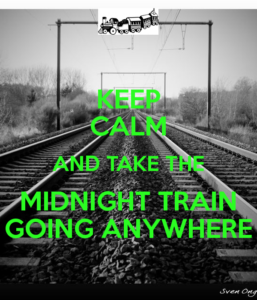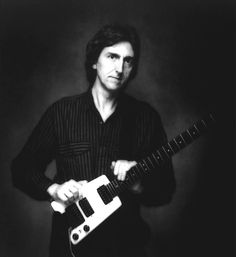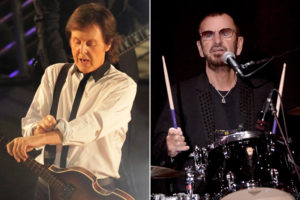A Ticket to Stop Believin’ that You Can Go Your Own Way
by Randall Auxier
You need to admit that you like the Journey song “Don’t Stop Believin’.” (Gotta love the apostrophe, too. God I do.) You know every word to this song (not that they’re hard to learn). You sing it loud when people aren’t around. I know you do. You go falsetto on the high notes, even if you’re a woman. It’s ok. We all do that too. Steve Perry wasn’t a normal human then, and it couldn’t last (and didn’t).
You also like four dozen other songs with exactly the same chord pattern –in musicians’ parlance it’s a I-V-vi-IV, also called “the four-chord song.” The Axis of Awesome has nicely documented it here. The six-chord is always minor, which is why it’s lower cased. But it isn’t chord structure I want to troubadize today. There is something else that you may not have noticed but that you like very much. But it’s a bit below the treble clef. It has to do with song-making. Many songs you love depend on it. I will look at three. In a later post I’ll go deeper into why you like this. I’m beginning with the exceptions to get you to love the rule.
Let’s start some place less obvious than “Johnny B. Goode.” The journey song is actually backwards. It captures a mood that carries it past bad lyrics. Yes, and I’m not even going to argue about this: the lyrics are quite bad. Song about a girl and a boy who . . . do what? Meet in a smoky room? On a train? Impossible to know. And, well, what happens? The movie never ends (wtf. what movie? were we watching a movie? on the train? at the bar? on the streets? but don’t let me go on and on about it). All this has no obvious relation to “street light people” or their hiding habits, or why our capacity for believin’ is somehow threatened by the preceding mish-mash, so that we need encouragement from . . . who? What the hell is the narrator’s viewpoint anyway? Storyteller? Nope. Spiritual advisor? He’s holding up a sordid one night stand as an example . . . of what? Is it alienation in city shadows? Small points of meaningless sexual connection that we are supposed to hold onto? Gambling with dice? Becoming emotionally overwrought? Does that city boy marry the small town, lonely girl, or just smell some perfume over the smoke? Or maybe he ends up with that wine-soaked singer? Or maybe he gets them both? And what the hell does the train have to do with any of it? Does it end at a bar? I thought it was goin’ “anywhere.” Maybe the bar is on the train. With a movie. Are they still in Detroit? What the hell is this song about? And by the way, there is no such place as South Detroit –apart from a bar in Windsor, Ontario, now mocking that line with hipster irony. Steve Perry later admitted that he tried “north Detroit” (which at least does exist) but, according to him, that just “didn’t sing.” I’m sorry but this song is gibberish and it certainly doesn’t stand up as poetry. (Ok, look, I know the song is a pastiche. I went to school. But a good pastiche? No.)
meaningless sexual connection that we are supposed to hold onto? Gambling with dice? Becoming emotionally overwrought? Does that city boy marry the small town, lonely girl, or just smell some perfume over the smoke? Or maybe he ends up with that wine-soaked singer? Or maybe he gets them both? And what the hell does the train have to do with any of it? Does it end at a bar? I thought it was goin’ “anywhere.” Maybe the bar is on the train. With a movie. Are they still in Detroit? What the hell is this song about? And by the way, there is no such place as South Detroit –apart from a bar in Windsor, Ontario, now mocking that line with hipster irony. Steve Perry later admitted that he tried “north Detroit” (which at least does exist) but, according to him, that just “didn’t sing.” I’m sorry but this song is gibberish and it certainly doesn’t stand up as poetry. (Ok, look, I know the song is a pastiche. I went to school. But a good pastiche? No.)
So this is crap. And yet, yet, it definitely works. It makes us feel both the alienation and the hope. These competing angsts resolve, somehow. It’s a mystery. But I’ll wager you haven’t noticed the bottom-most reason for your feelin’ of believin’. First I want you to consider Steve Smith‘s brilliant drumming. There is no drumming at all for the first minute of the song, just the driving left hand on Jonathan Cain’s piano. Then the drums are mere accompaniment to the strangers waitin’. But something magical occurs after the first chorus. As verse two sets in, the drums open up into an asymmetric agglomeration of tom-toms and cymbal-hat dings, building a roaring but rolling tension against that driving keyboard left hand (which never really lets us go). It builds, anthemic, celebratory, into climactic acts of musical believin’.
 But now listen to the bass, right where the line “strangers waitin'” is first sung. You will hear it. Ross Valory plays the growling, anticipatory descending scale that leads from the one-chord to the five-chord, on his punchy Steinberger bass. Then a different descent from the six-chord to the four-chord, with a skip and re-attack, in the mid-neck, mid-strings. Valory will continue to anticipate the roots of the chords throughout the song, complementing Smith’s perfect refusal to give your ear a clear two and four beat. The withholding of this expected, oh-so-even rock beat creates tension. Instead of hitting the snare on beats two and four, with the obligatory one and three on the kick drum, Smith hits an almost incomprehensible series of delayed, omitted and syncopated thuds and slaps that just prolong the tension, making you long for rhythmic symmetry and clarity.
But now listen to the bass, right where the line “strangers waitin'” is first sung. You will hear it. Ross Valory plays the growling, anticipatory descending scale that leads from the one-chord to the five-chord, on his punchy Steinberger bass. Then a different descent from the six-chord to the four-chord, with a skip and re-attack, in the mid-neck, mid-strings. Valory will continue to anticipate the roots of the chords throughout the song, complementing Smith’s perfect refusal to give your ear a clear two and four beat. The withholding of this expected, oh-so-even rock beat creates tension. Instead of hitting the snare on beats two and four, with the obligatory one and three on the kick drum, Smith hits an almost incomprehensible series of delayed, omitted and syncopated thuds and slaps that just prolong the tension, making you long for rhythmic symmetry and clarity.
Then, when you are desperate, Valory tells your ear what to think about this ruckus by descending with a skip and a growl into the the root. He doesn’t provide a groove. You’ll have to get that from the whole. He just lights a path of expectation to the root. It doesn’t mean a thing until you are singin’ with the band. You want to believe, more than Fox Mulder ever did. And that’s the whole song, whether you realize it or not. (Well, ok, Neal Schon‘s guitar sounds and Steve Perry’s vocal textures do have something to do with the feelin’.)
But these Journey guys didn’t pioneer the sonic strategy that grips you here. They , er, umm “borrowed” it, modified it, and turned it into the most downloaded song in human history. Sure, downloading is but twenty years old, generously interpreted, but this damned song is older than downloading, by almost enough to be its daddy, so give the Bay Boys a nod, huh? Yes, well, maybe “borrowed” is still too strong. The hired it. Yeah, that’s the ticket. Hired.
Before them, exactly the same trick was used by Fleetwood Mac in “Go Your Own Way.” John McVie does the same anticipatory descending scale strategy into the roots. He makes your ear know what to think. The tension in Mick Fleetwood‘s refusals of twos and fours are more exaggerated, but it adds to the relief and release when the arrangement gallops into the chorus with utter conviction and evens out into rock and roll. The arrangement ends up in double time in the climax with both snare and kick on all four beats. You know to go your own way, shall we say. McVie’s bass line is much better than Valory’s. It has to be. The song is weaker. But it growls a bit less because the drums are thinner. The more spare the drums are, the thicker the bass needs to be. Besides, a virtuoso drummer like Steve Smith covers a thousand musical needs; good bass player asks a new question “what can I do for the whole?”
But those Fleety boys didn’t make up the trick. It’s in “Ticket to Ride.” (Maybe that’s where Steve Perry’s train came from?) All the Beatles seem to agree that Paul told Ringo to do the syncopated thing on that song, and then he did the rest on bass. The kick-in on the high-ridin’ part and the double-time at the end were probably his doing too. He is a musicians’ musician, and he and Ringo now officially look younger than anyone in Fleetwood Mac or Journey. A deal with the Devil?
 Anyway, McCartney did that bass reversal in many ways. Listen to “Don’t Let Me Down.” It’s the same groove except that they sing the syncopations with the drums and then wander into rhythmic la-la land in the bridge. The bass is as fat and muddy as bass can get, and listen to all that bare, wondrous sonic space. It’s freakin’ fantastic, especially the bass solo. Now, it is no simple matter to reverse the anticipations of the popular ear. You have to move the popular ass first. Normally that’s done by slapping a snare on two and four against a thunkin’ kick and bass on one and three. But asses can be moved in other ways. And yes, this is songwritin’. For some songs, the groove and feel are more than half the task. There isn’t much melody in “Ticket to Ride” or in “Go Your Own Way.” The lyrics are pretty inane. Take away the droning guitars and the syncopated groove and kick, and there’s not much song left. (At least the Journey song has a melody, schmaltzy as it is.)
Anyway, McCartney did that bass reversal in many ways. Listen to “Don’t Let Me Down.” It’s the same groove except that they sing the syncopations with the drums and then wander into rhythmic la-la land in the bridge. The bass is as fat and muddy as bass can get, and listen to all that bare, wondrous sonic space. It’s freakin’ fantastic, especially the bass solo. Now, it is no simple matter to reverse the anticipations of the popular ear. You have to move the popular ass first. Normally that’s done by slapping a snare on two and four against a thunkin’ kick and bass on one and three. But asses can be moved in other ways. And yes, this is songwritin’. For some songs, the groove and feel are more than half the task. There isn’t much melody in “Ticket to Ride” or in “Go Your Own Way.” The lyrics are pretty inane. Take away the droning guitars and the syncopated groove and kick, and there’s not much song left. (At least the Journey song has a melody, schmaltzy as it is.)  Whining and shouting at her backside as she slams the door is the essence of the song concept of both the others. Lindsey Buckingham has on his side that none of us could live with Stevie Nicks, although we’d like to try. But it’s, at best, a pathetic break-up song. You want the real break-up song? Try “Landslide” –same relationship, far better lyric and melody ideas.
Whining and shouting at her backside as she slams the door is the essence of the song concept of both the others. Lindsey Buckingham has on his side that none of us could live with Stevie Nicks, although we’d like to try. But it’s, at best, a pathetic break-up song. You want the real break-up song? Try “Landslide” –same relationship, far better lyric and melody ideas.
As for “Ticket to Ride,” it’s cleverer than “Go Your Own Way,” by a quantum leap, but c’mon. Anyone can recognize wounded male pride in full bloom. The chances I’d take her side, having the full story? 95% minimum. She threw you over because your head is, well, it isn’t in the pure air, is it? Try not to give your nape a paper-cut next time you wipe. So even though we all like your songs, Msrs. Lennon, Buckingham, and Perry, it’s not your emotional depth or your poetry (even though, yes, we have been there ourselves). We like your rhythm section, Ringo and his brothers going boom, THOPP, boom, bah boom, THOPP. And we like Paul’s disciples tellin’ us what to feel with the bass. We all do. Whether you know it in your head, your ass has it figured out.




